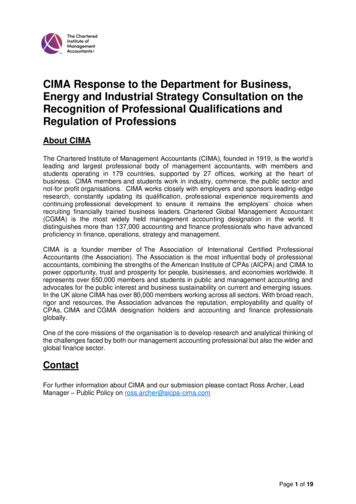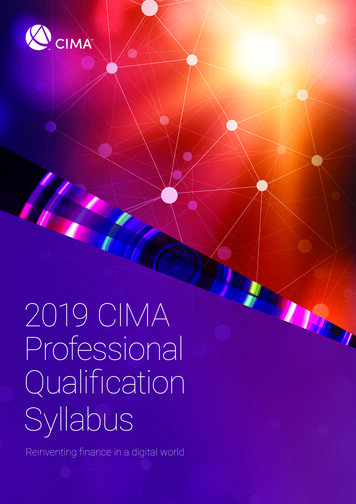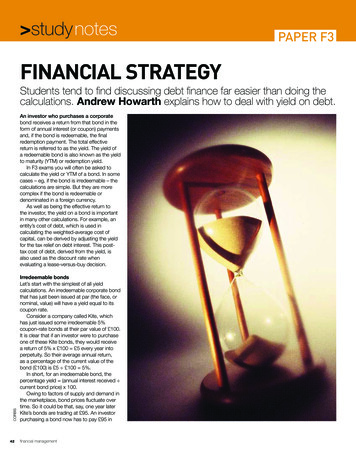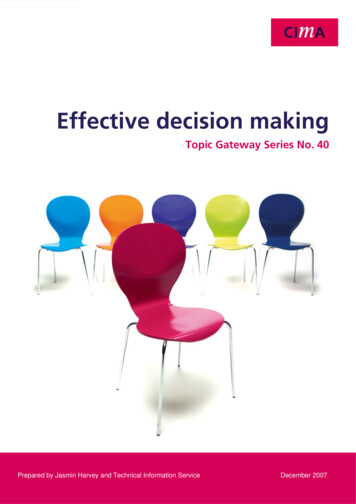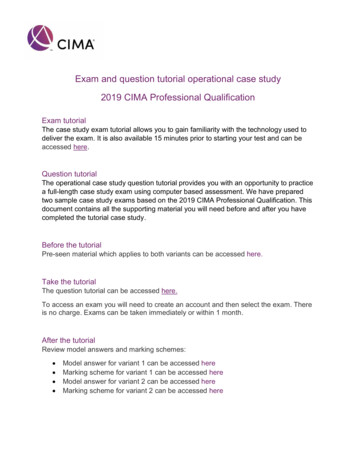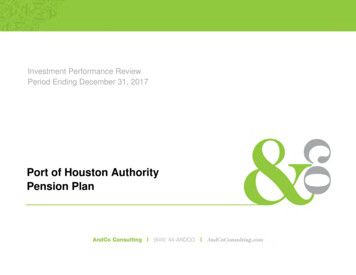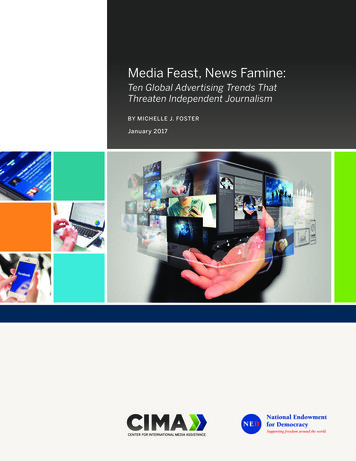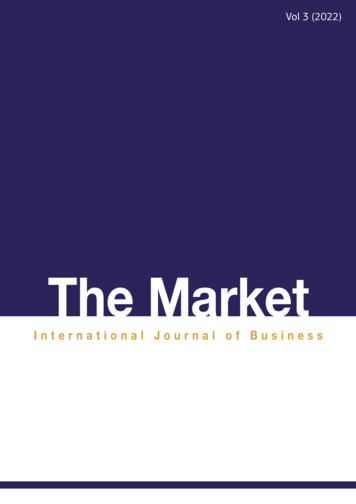
Transcription
Vol 3 (2022)
The Market: International Journal of BusinessThe Market: International Journal of Business is a scholarly, peer-reviewed research journal published annually by theCyprus Centre for Business Research at the Cyprus Institute of Marketing (CIM).We seek to promote new and productive interaction between various business disciplines and fields. We consider articlesthat express new and innovative ideas in Business, paying particular attention to developments in Cyprus and the broaderEastern Mediterranean area.Published by:Cyprus Centre for Business Research25 Zannetos street, Ayios AndreasNicosia, Cyprusmarket@cima.ac.cyFounding Editor: Prof. John KaminaridesEditor-in-Chief: Dr Constantinos Constantinou, CIMCopyeditor: Brian SaundersScientific Board:Dr Derek Watson, University of SunderlandDr Suresh Gamlath, University of West LondonDr Nicos Antoniades, DeVry University, Keller Graduate School of Management, New YorkDr Serhii Lehenchuk, Zhytomyr Polytechnic State University, UkraineDr Myria Kkali, CIMDr Maria Socratous, CIMDr George Afxentiou, CTL EurocollegeDr Katerina Pavlou, CIMDr Christiana Charalambidou, CIMDr Roman Puchkov, CIMDesign: Platforma119Submitting to The Market: International Journal of BusinessFor more information about the journal and guidance on how to submit, please see www.market.cima.ac.cy 2022. All rights reserved.Legally responsible person: Yangos HadjiyannisThe Market and its editors, publishers, owners and anyone else involved in creating, producing or delivering The Market do not assume anyliability or responsibility for the accuracy, completeness, topicality, or value of its contents, nor shall they be liable for any direct, indirect,incidental, special, consequential or punitive damages arising out of its contents.The Market is published by the Cyprus Centre for Business Research, which is part of the Cyprus Institute of MarketingISSN 2547-9202
PAGEEDITORIAL1BUSINESS AND LAW2Governance, board membership identity and socialised induction:A narrative on enabling an effective boardroom experience3 - 13D. Murphy and D. WatsonCYBER SPACE AND TRAININGNew challenges for the military. But new solutions in military education and training?1415 - 16D. Kerigan-KyrouDIGITAL MARKETING“Is It Funny?”: A thematic analysis of YouTube consumers’ perception and attentiontowards surreal and parody humour styles used in online video advertising1718 - 31L. Swas and M. KkaliTechnology acceptance model for digital health technologies and the effect of Covid-19on users’ behavior: the case of Cyprus.32 - 48D. ChristouHUMAN RESOURCE MANAGEMENT49Understanding the dimensions of human capital – organisational implications and application 50 - 60G. Green-McLennon and D. WatsonMANAGEMENTThe CIS strategy as a driver of competitive organizational resources6162 - 66P. Usaha, O. Alsalahat, J. Johnson, B.M. Shin and N. AntoniadesMARKETING AND CONSUMER BEHAVIOURFactors affecting consumer loyalty independent bookstores:How well are customer needs being met? A cross-generational case study.6768 - 80S.S. Christou and G. ThrasyvoulouONLINE GAMINGOnline games: Exploring future possibilitiesA. Terekhova and C. ConstantinouSHIPPING AND HUMAN RESOURCE MANAGEMENTCultural diversity and its impact on employee engagement;A case study on a multinational organisation.8182 - 878889 - 105E. PhilippouAuthors106 - 110Disclaimer: The contributing authors hold any potential liability for publishing an identical article to that of another scientific journal, without having first received theexplicit consent of the publisher in question. The Editorial Board of ‘The Market’, the Cyprus Centre for Business Research and the Cyprus Institute of Marketing may not beheld accountable in any way for such or similar acts.
EDITORIALDear Readers,We are delighted to welcome you to the third issue of The Market: International Journal of Business.The Market is a scholarly, peer-reviewed research journal published annually by the Cyprus Centre forBusiness Research and funded by the Cyprus Institute of Marketing (CIM). The journal considers articlesthat express new and innovative ideas in business, paying particular attention to developments inCyprus and the broader Eastern Mediterranean region. It publishes the results of research endeavoursthat show strong future prospects and articles that address the betterment of human life, as wellas business practices. The expert and dedicated editorial team solicits and welcomes articles fromscholars of all career stages and on topics related to all fields of business, either with a domestic oran international outlook.Thanks to the good work of our team, and thanks to the quality of submissions, The Market is nowhosted on the world’s top platforms: ProQuest and EBSCO, two of the world’s most-used databasesfor scientific journals.The Market aims to provide opportunities for the promotion of new dynamic business ideas to enhanceresearch in all business fields – from management, strategy, accounting and finance to HR, energy,marketing and shipping. The Market also welcomes contributions on emerging fields – for example,political marketing, a relatively new area that is continually gaining more traction worldwide. The goalof The Market is to create an increased awareness of important scholarly achievements and to hostdaring, adventurous research.In our third issue, we have once more ensured coverage of a plethora of contemporary and pressingissues and topics. These include articles linking business with cyber space, online gaming, shipping, aswell as articles that offer valuable insights into consumer behavior, digital marketing and corporategovernance. There’s also an article on understanding the dimensions of human capital. Salient issues,including the relationship between specific organisational resources and their significance to theaward-winning CIS Model, are analysed, too.In addition to these topics, and committed to the new generation of scholarship, The Market hascontinued to publish the top dissertations of CIM Master’s students. Special thanks must go here to DrKaterina Pavlou, Director of the Cyprus Center for Business Research and Academic Director (Limassol)and Dr Christiana Charalambidou, Head of Postgraduate Studies (Nicosia) and Permanent Lecturer inEconomics, for establishing the scheme and for guiding students from dissertation to publication.Deliberately broad in its appeal, The Market will continue to welcome articles in all fields related tobusiness. Following the successful 4th Annual Academic Conference that was organised recently by theCCBR, the fourth issue of the journal will run under the umbrella theme of the upcoming ConferenceIgniting the New World of Business.We hope that you will enjoy reading The Market as much as we have enjoyed putting it together. Andwe thank you for being with us on this journey.Thank you, and we look forward to reading your research paper and/or research note next time!Dr Constantinos ConstantinouEditor-in-Chief1
BUSINESS AND LAWGOVERNANCE, BOARD MEMBERSHIP IDENTITYAND SOCIALISED INDUCTION:A NARRATIVE ON ENABLING AN EFFECTIVEBOARDROOM EXPERIENCEByDenis MurphyDoctoral Candidate, University of SunderlandDr Derek WatsonAssociate Professor, University of Sunderland2
AbstractA cursory look at the literature in the area of corporate governance identifies a number of core themescurrently offering insights into boards and their changing role in organisational governance. Increasingdiscussion on diversity, gender, changing governance frames and the progressive conceptualisation of boardmembership as a profession in its own right, are all clear to be seen.Given that boards and their role in governance transcend many sectors from industry, finance, andretail to the more emotionally laden service industries such as regulation of health and social care, how canorganisations learn to grapple with the changing face of the boardroom and with wider societal expectationsof their boards?The suggestion in this thought paper is that by understanding the organisation’s governance frameand organisationally enabling the concept of board membership identity through a strategically aligned viewof induction as a process of socialisation, a better board dynamic can evolve.Keywords: Corporate Governance Frame, Board Member Identity, Socialisation, Sociocultural Perspective,Induction, OnboardingIntroductionGiven professional doctoral programmes’ emphasis on professional reflection (Cunningham, 2018)and the encouragement to evolve as researching, reflective practitioners (Fulton et al., 2013), it is unsurprisingthat the author recently had to reflect on his career while preparing a doctoral portfolio of reflection andevidence. What was surprising was that with the benefit of hindsight the author now realises that boardsand their role in governance have been at play in his career from the outset. Boards in all their guises arean organisational representation of an internal governance mechanism (Doyle, Murphy and Watson, 2021).And as such, boards influence and shape activity and organisational direction as decisions trickle down fromthe board, via management, to the frontline, in a manner similar to champagne flowing down a glass tower(Lornudd et al., 2021). In many situations this trickle can go unnoticed, even by those working within theorganisation. This is unsurprising when you read Brennan’s 2010 conclusions that, ‘corporate governanceis a relatively new concept in business’, and that research in the field is ‘at an early stage of development’(Brennan, 2010, p. 18). Corporate governance is still relatively new and a woolly concept to many. Boards, asa form of internal governance, continue to evolve and respond to changing contexts and are by their naturecomplex and complicated (Adams, 2017).Governance can take many forms, and as such mean different things in different contexts. Consequently,the same is true for boards and their roles. Board structures can range from a family meeting around a dinnertable for a family-run organisation, to the much more structured boardroom experiences of the corporatesector, with many variations in between. Our previous work in this journal outlines the main four historicaltheoretical models used to practically implement governance within organisations, regardless of context.These are agency, stewardship, resource dependency and stakeholder theory (Doyle, Murphy and Watson,2021). Who serves on a board, how they are recruited, inducted and the activities they engage in, are for manythe realm of the unknown. However, it is these underlying theories of governance that have been, and aredriving, the responses to the questions about practice.A post Enron and Barings Bank society has resulted in an era where the world of the boardroom isbeing scrutinised more deeply. We are seeing calls for democracy in membership, transparency in decisionmaking and growing public expectations of accountability for the decisions taken (Leisen and Swan, 2019).3
Life within the boardroom is without doubt changing. Keeping pace with these changes and demands (somemandated by law, others through voluntary guidance) is placing increasing pressures and growing workloadson boards needing to demonstrate compliance. Interestingly, many boards opt to take on additional nonmandated compliance as a means of clearly and publically demonstrating a willingness to embrace the newera of transparency and compliance (Aragón-Correa, Marcus and Vogel, 2020).With ever increasing workloads, how can we enable our boards to perform better? How can we equipthem and support them to discharge their governance function effectively? And how can we ensure our boardmembers work collectively in the best interests of the organisation? To help explore these questions and equipthe reader with practical guidance which they can apply in practice to their board engagement, this paperexplore three independent, but we suggest related, concepts. First, we briefly explore and recount how thechanging governance paradigms are influencing the shape of board membership and its activities. We stressthe need to be cognisant of previous board frames, why they were enabled and why they have been changed.We then explore how the evolving concept of the professionalisation of board membership itself as a quasiprofession may go some way to help standardise and empower board members’ experiences and expectations.The focus here is on clarity of role and rationale for director engagement and the setting of expectations forand of directors. Finally, we investigate different perspectives on what the board induction experience shouldbe, its aims, objectives and approaches.The paper concludes by suggesting a combined understanding of these three concepts and howembracing them in practice in a coordinated manner within the organisation may lead to improved boardmember experiences, organisational board effectiveness, as well as improved collective decision making andaccountability.Governance evolutionary frames and expectationsFor some, corporate governance and the boards that enable, enforce or bring life to the concept withinorganisations, are still viewed as a phenomenon or force that acts upon their everyday working lives with littlein return. Some view boards as the untouchable beings living in their ‘ivory towers’ (Davis, 2016, p. 44), oroperating out of the ‘C-Suite’ (Trainor, 2020, p. 467) with little awareness of real world issues. Others recounteven less flattering views of board members suggesting boardrooms are populated by those who are ‘male,pale and stale’ (Groutsis, Cooper and Whitwel, 2018, p. 12). For many, until recent decades at least, this viewof males of a certain age sitting in judgement in the ivory tower being representative of corporate governanceand boards will have been a perceived reality. This author’s own experiences however suggest that such a viewof boards is at best an outdated view of the realities of current corporate governance paradigms, and of thosewho serve in the boardroom. Such views take little account of the dramatic and ongoing changes that haveoccurred and continue to occur internationally within the corporate governance arena in many sectors.Post Enron, and the countless other financial and governance scandals since, the world of corporategovernance has been exposed to a programme of change and regulation in most countries. We must rememberthat board performance is influenced by the condition of its operating economy, institutional and nationalcontext (Zhou, Owusu-Ansah and Maggina, 2018). These also influence board composition, tasks and activity(Borlea, Achim and Mare, 2017), so the enactment of corporate governance frames are driven by countrylevel regulations in the first instance. An alternative view of corporate governance and boards has evolved inmany countries in recent decades. It places boards in an ever changing temporal framework, responsive tosocieties changing needs and expectations of what corporate governance means. This new view can be seenin the literature where we can identify increasing emphasis on explorations of board member diversity (Khatibet al., 2021), board’s services tasks, functions or roles (Åberg, Bankewitz and Knockaert, 2019), the need for4
corporate transparency (Ardigó and Zúñiga, 2019), and board’s impact on corporate social responsibility andsustainability (García Martín and Herrero, 2020; Endrikat et al., 2021), to mention just a few. In practice, weare seeing many of these concepts being translated into the national context either on a voluntary basis orbecause of mandated requirements to which boards must demonstrate compliance. Examples include calls toaddress the male/female gap in the boardroom and in working society at large in Cyprus (Kouta, Parmaxi andSmoleski, 2017), formalising the recruitment and selection process for state boards, such as the case is inIreland (Horan and Mulreany, 2021) and mandating in law the need for directors to sign disclosures of conflict(Koh, 2017).The preceding demonstrates a change has happened, and is continuing to happen in corporategovernance, and this is being experienced by boards in their boardroom activities. Boards are no longer justbeing stacked with the ‘great and the good’ (Benton, 2017, p. 9), to look after the owners’ interests. We areliving through a paradigm shift in corporate governance (Vyas-Doorgapersad and CanAktan, 2017), whereexpectations are high and in a world transformed through social media (Fenwick and Vermeulen, 2018),compliance is no longer a luxury, it is necessary. Indeed, it is argued that we are entering a world where ‘bestpractice isn’t good enough’ (Wong, 2016, p. 58) and more is now needed and expected.Positioning boards and enabling them to respond to such dramatic change quickly and effectively, wesuggest, starts with ensuring organisations and their boards have a clear understanding of the role and purposebehind their existence and why such changes to support their governance form are required. Unsurprisingly,many do not clearly understand the functions boards serve, due to the ambiguity used in defining tasks andfunctions and the ever expanding expectations placed upon them (Åberg, Bankewitz and Knockaert, 2019).For many organisations this has resulted in increasing use of management consultants to assist the board(Gendron, Bertrand and Tremblay, 2021). Yet, Grendron and colleagues suggest over use of consultants maycompromise organisational governance. They question consultant’s understanding of the regulatory frame andcontext, their level of impartiality and, in some instances, boards almost outsourcing of decision making tothem as they perceive consultants to be the experts and those with the knowledge.To summarise, the key message evolving in this section is that corporate governance continues tochange. If it is assumed that boards will remain a key actor in the corporate governance frame, then weshould expect change in what and who constitutes the board and what its activities will be. In creating thisnew boardroom reality, organisations should transparently document the role, the rationale and the valuesof having a specific board form and function and of its enactment in practice. Such documentation shouldacknowledge any changes in function and structure and the rationale behind it. In moving forward it is alsoimportant to recognise where we have come from, or we may be destined to errors of the past. Having a clearorganisational understanding of the board’s evolution, role, purpose and activities enables and informs boardmembers of expectations. This in turn makes historically grounded and contextualised decision making easierin practice.Board membership identityIf recruiting the best directors and applying best practice in the boardroom is no longer ‘good enough’(Wong, 2016, p. 58), perhaps there is a possible solution through the exploration of board membership identity.Such a concept is grounded in theories of social identity, professional identity, identification and accountability(Alhossini, Ntim and Zalata, 2021). Discussions in this area are not new, with calls over a decade ago for newresearch paradigms within the boardroom, paradigms focusing on social, behavioural and identity theory(Huse et al., 2011). Implicit within the concept of board member identity are the concepts of professionalismand professional identity. Both of these themes are well documented in the literature.5
Professional identity is a social construct and stems from an interplay of a multitude of factors(Han, 2017). It results in the individual becoming a recognised member of a profession (in our case a boarddirector) and also distinguishing them from those who are not (Trede, Macklin and Bridges, 2012). Evolvinga professional identity is enabled through socialisation (Tomlinson and Jackson, 2021) and a time basedconstruct that evolves from the interplay of society, context and the profession (Murphy, Gilligan and Watson,2021). Attaining a professional identity is about learning how to act within the profession’s context (Skinner,Leavey and Rothi, 2021). For board membership then, it can be assumed there are skills and competencesrequired to effectively carry out the board member functions over and above the specific skills that may havebrought that director to the boardroom table. Such skills are not constant and the board needs to be responsiveand adjust their skills base to evolving contexts (Hoppmann, Naegele and Girod, 2019).The literature on board member identity emphasises the importance of identification, namely withwhom the director primarily identifies. Who they most identify, associate or empathise with, will influencethe way they behave and make decisions within the boardroom (Hillman, Nicholson and Shropshire, 2008;Jonsdottir et al., 2015; Veltrop et al., 2021). Assuming the board’s prime role is to protect the interests of theorganisation and its stakeholders and to drive corporate governance, accountability and strategic direction(Madhani, 2017), then logic would dictate that those who associate with the board, as an entity in its ownright, are the candidates most likely to have greatest impact. Some contributors to the literature suggest thatbusiness group affiliation (board affiliation in our context) is an important contextual factor in creating firmperformance (Aggarwal, Jindal and Seth, 2019). It is suggested that directors who identify strongly with beinga director (director role identity), feel accountable for the entire organisational activity and gain a sense ofpride from acquiring a broad knowledge of the organisation’s workings (Elms and Nicholson, 2020).So the message from the literature is that selecting board members is grounded in the nationalregulatory context, and that these vary considerably (Baum, 2016). Thus, who serves on boards, and how theyare appointed is, for many, dictated by regulations, and emanates from the temporal governance form evidencedwithin the sector and context at a given time (Murphy, Gilligan and Watson, 2021). However, regardless of theroute to the boardroom, the literature, at least that exploring identity, social and behaviour-related theories,concludes that encouraging the concept of director identity as a professional identity construct may addvalue and improve boardroom experiences. It in essence enables an organisational consciousness within theboardroom. However, there are of course cautions here, in that too much identification may lead to groupthink and lead those who strongly associate with the identity to become stale (Veltrop et al., 2018). The key,Veltrop et al. advise, is monitoring tenure and ensuring the board is refreshed regularly so as to bring in newperspectives. The concept of diversity within the boardroom again comes to the fore here, so we begin tosee interrelationship between the concept of board membership identity and our original discussion in thechanging face of governance forms.Within this concept of board tenure and diversity we are seeing increasing discussion andrecommendations on the inclusion of independent or lay directors (Ji et al., 2021). There are also calls fordiversity with regards gender (Khatib et al., 2021), ethnicity and race (Hogan and Huerta, 2019; Zaid et al.,2020), as well as cognition and learning style (Du and Xu, 2018) and previous experience (Chandrakumara,McCarthy and Glynn, 2018). Each of these can be viewed as sub analysis units of diversity within the boardroom.In noting the array of topics discussed within the diversity arena, it must also be noted that as of yet opinionon its impact is mixed. However, one aspect that can be concluded as we increasingly see diversity within theboardroom, is that our board induction, training and development programmes must evolve if the conceptof board member identity is to be enabled in practice. It must enable our directors to become effective andvaluable members of an increasingly diverse ‘community of practice’ (Wenger, 1998) of governing directorsor board members. A community that must share the same organisational vision and understanding of thecontext in which the organisation they govern operates if it is to be effective. A community that must work asa collective in its organisation’s best interest above all other interests.6
Becoming through induction and socialisationApproaches to board induction tend to follow for the most part standard approaches to organisationalinduction or onboarding. Indeed the organisational induction process has become one of the core HumanResources functions (Caldwell and Peters, 2018). Traditional approaches to induction have tended to focus oninformation transfer, policy sign off and for the most part have gained an image of being tick box exercises,focusing on the demonstration of compliance driven by national legislative agendas (Caldwell and Caldwell,2016). Such traditional views on induction carry with them inherent views about knowledge and practice. Theybring with them an assumption that an organisation’s knowledge can be documented and thereby transferred tonew hires. It is about a standardised step by step approach and leaves little room for personalised experiences.Surprisingly, as little as 32% of companies have been found to provide for a formal induction process(Baker and DiPiro, 2019), with some in the literature suggesting that, in some organisations at least, theattitude towards induction is a ‘sink or swim’ mentality (King, Roed and Wilson, 2018, p. 479). Such an approachmay account for a recent survey in the Unites States showing that only 12% of staff felt their organisation did‘a great job at onboarding’ (Gallup Inc. 2017, p. 36). It is therefore, perhaps, understandable that alternativeapproaches to induction or ‘onboarding’ have been researched and proffered in the literature. One stream ofthese focus on the concept of socialisation in the practices and context of the organisation. The focus is on theenabling of the person to become an effective organisational participant. Clearly such models are grounded indifferent perspectives of knowledge. The narrative of this socially-based view aligns with sociocultural viewson knowledge and learning. A view where knowledge is considered to be situated in context (Lave and Wenger,1991), mediated in practice (Wertsch, 2008) and filtered through cultural and historical context (McCormickand Murphy, 2008). In essence, the focus is on experience, shared understanding, context and practice, ratherthan just document and policy. It is about recognising the importance of professional identity, in becoming amember of a specific community of practice (Wenger, 1998).One such induction or onboarding model, for example, suggests the key to successful onboarding isabout enabling an understanding of organisational culture, role clarity, increasing self-confidence and socialintegration (Badshah and Bulut, 2020). Many others have also stressed the importance of socialisation and aconcern with identity formation (Cooper-Thomas and Anderson, 2006; Becker and Bish, 2021). Indeed, someauthors suggest that socialisation should commence early and even before the inductee commences theirrole, or enters the boardroom in a director’s context (Saks and Gruman, 2018). Unlike traditional upfront oneoff induction, a socialisation model is viewed as an ongoing experience that helps the inductee to evolve theirexpertise within context over time (Ferrazzi and Davis, 2015; Caldwell and Peters, 2018; Harris et al., 2020).Approaching onboarding with such a perspective enables the practitioner to see beyond the now ofthe boardroom and is a paradigm shift in induction process (Ferrazzi and Davis, 2015). It encourages youto make clear the assumptions being made and to acknowledge that everyone brings with them their ownhistory, perspective or baggage. Thus, an element of effective onboarding may be about unlearning (Beckerand Bish, 2021). Enabling socialisation at an early stage opens you to the concept of facilitating new members’observation of practice before joining the board formally, the possibility of an overlap of director successionand transition and the recognition of the concept of the uniqueness of what it is to be a board member ordirector. This, in turn, will foster a greater sense of belonging and increase director self-confidence and a senseof collective endeavour. Socialisation approaches to induction improve director experience and organisationaloutcome (Irshad and Bashir, 2020).Thus, induction based on a socialisation model inherently acknowledges what has gone on in the past.It brings with it the social history and narrative of the board and of the governing frame that established andenables it. It acknowledges the existence of a social community of practice at play within the boardroom andof the importance of the less specific and intangible skills the director will need to enact in the boardroom toengage effectively with the other members of the community of governing directors.7
Discussions on a working model to encourage a socialisation approach to board member inductionAn element of the author’s current doctoral research is exploring the relationship between the threeconcepts of evolving governance forms, board member identity and an onboarding experience focused onsocialisation, specifically within the context of the professional regulation of an Irish healthcare profession.The argument is that board members inducted in a proactive awareness of these concepts are better equippedto practice more effectively in the boardroom. The focus is on empowering new members through the sharing ofinformation and experiences. These experiences are grounded in board members’ practice, through discussionand exchange with existing or departing members, so as to gain greater clarity of the board member role, itsexpectations and how it has be
Dr Nicos Antoniades, DeVry University, Keller Graduate School of Management, New York Dr Serhii Lehenchuk, Zhytomyr Polytechnic State University, Ukraine . Keywords: digital health, technology acceptance, medical app, covid-19 influence, technology acceptance mode (TAM), undefined theory of acceptance and use of technology (UTAUT) 1. Introduction
